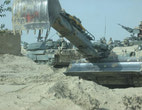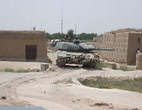Hoovering in Afghanistan
By: Capt P.E. Leonard
14 June 2007
Just as OC A Squadron, Major Dave Broomfield, left Afghanistan for his three weeks of leave in Europe the 2IC, Captain Craig “Heat Score” Volstad, stepped up to replace him and the Squadron’s operational tempo immediately kicked into high gear. One day the Squadron was planning a series of ranges and the next we were conducting an array of security operations in the Zhari-Panjwaii district.
The Squadron’s two most recent major operations, Op HURRICANE II and Op HOOVER, were once again as part of the ‘Hotel’ Company Combat Team. Having lived and worked with H Company for our first month in theatre, in the desert of the Maywand District during Op ACHILLES, the Squadron had a strong relationship at all levels, which would prove to be invaluable. The initial plan had counted on the Combat Team rolling into the Nalgham district to make our presence known and liaise with the local leadership; the Taliban, however, had different ideas. After advancing only 500m into the area we came under fire. Throughout the next two days, the Squadron targeted and engaged Taliban insurgents in the middle of a built-up area. The fire from the tanks was precise and effective, reducing collateral damage to local infrastructure. In the complex terrain the Squadron has been operating in, it has been the steady hands of our crews that have contributed to our success so far.
For Op HOOVER, the intent was a little different; with the recent removal of two powerful local Taliban leaders, the Battle Group looked to capitalize on confusion within the enemy’s ranks. Between 17 – 25 May, the Squadron participated in clearance operations through the Nalgham region. We advanced side by side with H Company, the Afghanistan National Army, and the Afghanistan National Police through open fields and built-up areas, coming under contact from the Taliban and clearing them from their positions when the opportunity arose. On day one, the Fire Base, commanded by Captain Eric Angell, and Leaguer came under fire from several RPGs and small arms fire. T1B and T13 neutralized the attack prior to sustaining any direct hits. Day two started off with a bang, when one of the mine roller tanks struck its first mine. The combat team heard the explosion first, but were settled considerably when, mere seconds later, the crew commander came over the radio as the true professional with a “crew all ok, gunnery systems ok, rollers ok – mine contact report to follow.” The loader of the tank recalls the events: “it was a big boom and, at the same time, like a shovelful of dirt in the face!” Shortly after the mine strike, the lead tanks and LAVs came under small arms and RPG fire; A gunner, described the events of these days as hectic, but echoes the comments of other soldiers: “I never hesitated. When you see the RPG … you’re just doing your job.” Not that it was just the tank crews who were busy during these days; our maintenance and recovery crew, under the direction of Master Corporal Rod Purchase, was busy dealing with the real world problems of tanks and LAVs getting stuck in the deep wadis and swampy agricultural areas of Nalgham. These recoveries under contact were, as one can imagine, quicker than anyone thought possible, a feat accomplished by the courage and work ethic of our maintenance crews.
Just in time for the final phase of Op HOOVER, Major Dave Broomfield returned to his Squadron to find it a combat-proven sub-unit. With the plan for phase IV of the operation already drawn up by Captain Craig Volstad, the OC took control of the Squadron for the execution of Phase IV of Op HOOVER. This phase of the operation was by far the most complex; a battle group operation that included the participation of three Companies of Afghan National Army (ANA) soldiers and elements of every Canadian sub-unit currently in Kandahar. We cleared through the entire of District of Nalgham and saw little in the way of kinetic activity from the Taliban. However, one tank was left immobile after striking a large mine (again, thanks to our equipment and training, all soldiers were unhurt) and, sadly, one soldier from the OMLT (the Canadian Operational Mentor and Liaison Team working to train the ANA) was killed by a landmine. Other than a few RPG rounds fired at the Leaguer, the Taliban were largely nowhere to be seen.
The soldiers of A Squadron have responded remarkably well to this increased pace of operations and our presence here continues to have a positive and life-saving impact in the Battle Group. Amazingly, as the heat continues to rise inside the tank the crews are adapting and finding ways to fight the tank in the most extreme conditions. That being said, credit must be given to our medical team, led by the talented Master Corporal Glenn Stryker, which has contributed greatly to the continuing health of the troops. At the end of these operations, the Squadron’s reputation within the Battle Group had been firmly established and the tanks have once again proven their value by saving lives and demonstrating to the Taliban our freedom of movement in their own back yard. In addition, we have become increasingly more confident in our equipment, training and leadership that can only be gained through the kind of work that we’ve been conducting in the past month. Morale of the Sqn could not be higher. Regretfully, two members of the Squadron have returned to Canada due to injuries… our thoughts are with you and your families. Stay strong and proud, you are members of A Squadron and are Strathcona’s.
Although time has passed very quickly and we are past the mid-tour hump, everyone continues to look forward to our return home. Until next time, we thank our families and friends back home for their support – Perseverance.




